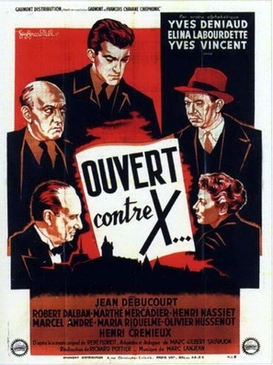Henri Nassiet (1895–1977) was a French actor.

Behind the Facade is a 1939 French drama film directed by Georges Lacombe and Yves Mirande and starring Lucien Baroux, Jules Berry and André Lefaur. The film's sets were designed by the art director Lucien Aguettand. It was shot at the Epinay Studios in Paris.

Jericho is a 1946 French war film directed by Henri Calef based on Operation Jericho. During the Second World War the Royal Air Force and the French Resistance take part in a joint operation known as "Jericho" to free fifty civilians being held as hostages by the occupying German Army in Amiens.

Clara de Montargis is a 1951 French drama film directed by Henri Decoin and starring Ludmilla Tchérina, Michel François and Roland Armontel. It was made at the Epinay Studios in Paris. The film's sets were designed by the art director René Renoux.

Three Telegrams is a 1950 French drama film directed by Henri Decoin and starring Gérard Gervais, Pierrette Simonet and Olivier Hussenot. The film's art direction was by Auguste Capelier. It was made at the Billancourt Studios in Paris.
Frank Villard was a French film actor. He was born François Drouineau in Saint-Jean-d'Angély.

Yves Vincent was a French film and television actor.

The Drunkard is a 1953 French drama film directed by Georges Combret and starring Pierre Brasseur, Monique Mélinand and François Patrice. It was shot at the Billancourt Studios in Paris. The film's sets were designed by the art director Marcel Magniez. It is based on the 1898 novel of the same title by Jules Mary which had previously been made into a 1921 silent film The Drunkard and a 1937 sound film The Drunkard.

I'll Get Back to Kandara is a 1956 French drama film directed by Victor Vicas and starring François Périer, Daniel Gélin and Bella Darvi.

The Cupid Club is a 1949 comedy crime film directed by Marc-Gilbert Sauvajon and starring Pierre Blanchar, Simone Renant and Yves Vincent. It was shot during 1948, but released the following year. It was made at the Photosonor Studios in Paris, with sets designed by the art director Eugène Delfau.

Savage Triangle is a 1951 French drama film directed by Jean Delannoy and starring Madeleine Robinson, Frank Villard and Henri Vilbert. The film's sets were designed by the art director René Renoux. It was shot partly on location in Marseille where the film is set.

Facing Destiny is a 1940 French spy drama film directed by Henri Fescourt and starring Jules Berry, George Rigaud and Josseline Gaël. It is based on the 1938 novel of the same title by Charles Robert-Dumas. The film's sets were designed by the art director Claude Bouxin. It was produced and distributed during the Phoney War period.

The Innocent is a 1938 French comedy drama film directed by Maurice Cammage and starring Noël-Noël, Madeleine Robinson and Henri Nassiet. It was entered into the 1938 1938 Venice Film Festival. The film's sets were designed by the art directors Lucien Jaquelux and Marcel Magniez.

The Case Against X is a 1952 French crime thriller film directed by Richard Pottier and starring Yves Deniaud, Elina Labourdette and Yves Vincent. It was shot at the Saint-Maurice Studios in Paris and on location in the city. The film's sets were designed by the art director Lucien Carré.

Vidocq is a 1923 French historical drama film directed by Jean Kemm and starring René Navarre, Elmire Vautier and Rachel Devirys. It is based on the novel of the same title by Arthur Bernède. The film's sets were designed by the art director Louis Nalpas.

One Only Loves Once is a 1950 French drama film directed by Jean Stelli and starring Françoise Rosay, Renée Faure and Marcel Herrand. It was based on a novel by Paul Vialar. The film's sets were designed by the art director Lucien Carré.

The Happy Man or The Man of Joy is a 1950 French comedy film directed by Gilles Grangier and starring Jean-Pierre Aumont, Simone Renant and Jacques Morel. It was based on a play of the same title by Paul Géraldy and Robert Spitzer. The film's sets were designed by the art director Guy de Gastyne.

Desperate Decision is a 1952 French drama film directed by Yves Allégret and starring Danièle Delorme, Henri Vidal and Jean Debucourt. It was shot at the Joinville Studios in Paris. The film's sets were designed by the art director Alexandre Trauner.

Madame Sans-Gêne is a 1941 French historical comedy drama film directed by Roger Richebé and starring Arletty, Aimé Clariond and Maurice Escande. It is based on the 1893 play Madame Sans-Gêne by Victorien Sardou and Émile Moreau inspired by the life of Catherine Hubscher. It was shot at the Saint-Maurice Studios in Paris and on location at the Château de Grosbois. The film's sets were designed by the art director Jacques Krauss.

Business Is Business is a 1942 French drama film directed by Jean Dréville and starring Charles Vanel, Aimé Clariond and Jacques Baumer. It was shot at the Studios Francois 1er in Paris. The film's sets were designed by the art director René Renoux.


















